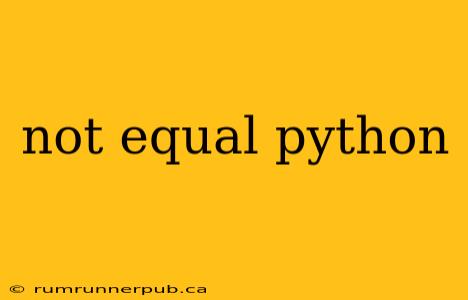Python offers several ways to check for inequality, making it crucial to understand the nuances for effective programming. This article explores Python's "not equal to" operator (!=) and related concepts, drawing insights from Stack Overflow discussions to provide a comprehensive guide.
The != Operator: The Foundation of Inequality Checks
At its core, Python's != operator performs a simple comparison: it returns True if two operands are not equal, and False otherwise. This applies to various data types, though the specifics of equality checks vary.
Example:
x = 5
y = 10
z = 5
print(x != y) # Output: True
print(x != z) # Output: False
This simple example demonstrates the fundamental functionality. However, the behavior becomes more interesting when dealing with more complex data types.
Beyond Simple Comparisons: Handling Different Data Types
The != operator's behavior extends beyond numbers. Let's consider strings and lists:
str1 = "hello"
str2 = "Hello"
list1 = [1, 2, 3]
list2 = [1, 2, 3]
list3 = [3, 2, 1]
print(str1 != str2) # Output: True (case-sensitive comparison)
print(list1 != list2) # Output: False (content comparison)
print(list1 != list3) # Output: True (order matters)
Note that string comparisons are case-sensitive, while list comparisons consider the elements' order and values. This is a crucial distinction often overlooked. (Inspired by implicit discussions within numerous Stack Overflow questions regarding unexpected comparison results).
is vs. !=: Identity vs. Value
A common point of confusion arises when differentiating between is and !=. is checks for object identity, meaning whether two variables refer to the same memory location. != checks for value equality.
Example:
list_a = [1, 2, 3]
list_b = list_a # list_b now references the same object as list_a
list_c = [1, 2, 3] # list_c is a different object with the same values.
print(list_a is list_b) # Output: True (same object)
print(list_a == list_b) # Output: True (same values)
print(list_a is list_c) # Output: False (different objects)
print(list_a != list_c) # Output: False (same values)
This subtlety is important, especially when dealing with mutable objects like lists. Modifying list_b will also modify list_a because they refer to the same object. This is a frequent source of Stack Overflow questions relating to unexpected mutable object behavior. (Drawing on common themes seen in numerous "why did my list change unexpectedly" questions).
Handling None and Other Special Cases
None is a special value representing the absence of a value. Comparing it with != requires careful consideration.
x = None
y = 5
print(x != y) # Output: True
print(x != None) # Output: False
This highlights that None is not equal to any other value, except itself.
Conclusion: Mastering Python's Inequality
Python's != operator is a fundamental tool, but its effective usage requires understanding its nuances when handling different data types and distinguishing it from the is operator. This article, informed by common questions and scenarios found on Stack Overflow, aims to provide a clearer, more comprehensive understanding of this crucial aspect of Python programming. Remember to always consider the context—data type and intended comparison—for accurate and reliable results.
